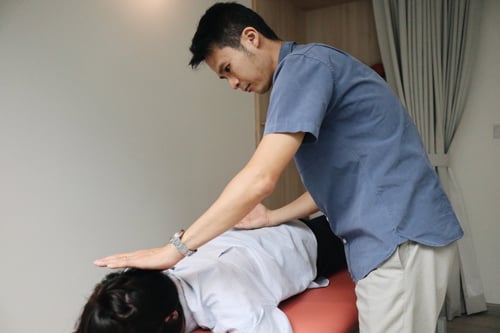Heavy lifting, repetitive movements and sitting at a desk all day at work can really take a toll on your body. A study conducted by the Singapore General Hospital (SGH) looked into the prevalence of neck, shoulder and back pain among office workers in Singapore, and found that 73.4% of the 324 respondents reported experiencing pain in at least one of those body parts.
Pain can be caused by a variety of life stressors including physical stress (e.g., sitting for long periods), chemical stress (e.g., gluten and dairy), as well as emotional stress (e.g., relationship issues). If your lifestyle continues to stress these areas of pain, you may also experience other symptoms such as waking up tired, fatigue, anxiety, headaches, digestive issues, sleep issues, and low energy; problems that could interfere with your daily work and personal life.
Suffering from neck, shoulder and back pain?
Spinal Flow Technique (“Spinal Flow”) practitioners from RealEase, David and Rowena, share some common mistakes you might be making that could be causing the pain, and how you can treat them for a pain-free life.
Common Mistakes Causing Neck, Shoulder and Back Pain
Being in the same position for an extended period of time
Our ancestors walked at least eight hours today; our bodies were made for moving. The problem with many of our lifestyles today is that we are often sitting for eight hours a day.
According to Cornell University Department of Ergonomics, up to 90% more pressure is put on your back when you are sitting in comparison to when you are standing. Whether you spend a huge chunk of your day sitting at work, in the car, or at home, habitually sitting in ways that cause tension and imbalances in your back and neck, could be a cause for your pain.
Postural habits
While you may not feel any pain within just a few hours of sitting with poor posture, over time the stress that it places on your spine can lead to back pain by causing muscle, disc and joint problems. Poor postural habits include sitting or standing with your head forward and hunched shoulders (especially when working on computers), slouching in chairs or sitting with your legs crossed.
Sleeping position
On average, we spend about 2,820 hours a year sleeping. Sleep is essential for your body to recover and reset for the day ahead.
Many don’t realise the importance of spine alignment while sleeping. Sleeping on your tummy and with your neck twisted to one side could cause a blockage of the messages between your brain and body which can stop vital healing from happening and also be a contributing cause to the neck, shoulder and back pain you’re experiencing.
Consuming highly inflammatory food
The food that we eat can also contribute to the physical discomfort we might be feeling.
Highly inflammatory foods that contain dairy (cow’s milk, butter, cheese) and gluten, such as baked goods made with wheat flour, wheat noodles, soya sauce, for example, can cause inflammatory responses in the body that can make itself known in a variety of ways - one of them being joint pain and body aches.
Even if you are not diagnosed with gluten or dairy sensitivity, eliminating the intake of food containing gluten and dairy can have a surprising impact on the aches and pain as well as other symptoms such as allergies and eczema.
Exposing yourself to endocrine disruptors
Inadvertently consuming or exposing yourself to known endocrine disruptors, such as bisphenol-A (BPA) and bisphenol-S (BPS); commonly found in plastics and thermal cash register receipts, parabens in shampoo, hand wash, and skin products, can also be a cause of the bodily aches you are experiencing.
A recent study by the University of Alicante and Miguel Hernández University found that BPA modifies the behaviour of certain neurons and increases the feeling of pain.
What to Do to Reduce Neck, Shoulder and Back Pain
- Move every 20 minutes by taking a short walk or doing some stretches, particularly if your job requires long hours of being in the same position (e.g., sitting at a desk)
- Put aside at least 20 to 30 minutes everyday for physical activity or movement that you enjoy (e.g., walking, cycling or going for a group fitness class)
- Identify poor postural habits that are a cause of physical stress and pain, and change it (e.g., if you carry your bag on only one side all the time, make a conscious effort to change sides occasionally or on alternate days of the week)
- Ensure you are sleeping with proper spinal alignment to allow your body to optimally recharge and recover during your sleep by sleeping on your side or back with a pillow that supports the neck alignment with the spine
- Get assessed by a professional to find out the root cause of your pain and get professional advice and treatment to alleviate the pain

Looking to resolve any pain in your neck, shoulder and back? Find out more about our wellness services here
Contributor:

RealEase is founded by husband and wife, David Thoo and Rowena Choo.
Spinal Flow is a powerful yet gentle healing modality that facilitates healing via the nervous system and consists of light touches on specific areas of the spine we call access points without manipulation, popping or cracking. Spinal Flow facilitates a full rewiring of the brain and the body relearns what it already knew, to begin with — how to self-heal.
Spinal Flow has helped with recovery from chronic headaches, back pain, disc injuries, low energy, infertility, digestive complaints, stress, depression and more. We also see tremendous improvements in autism symptoms.



